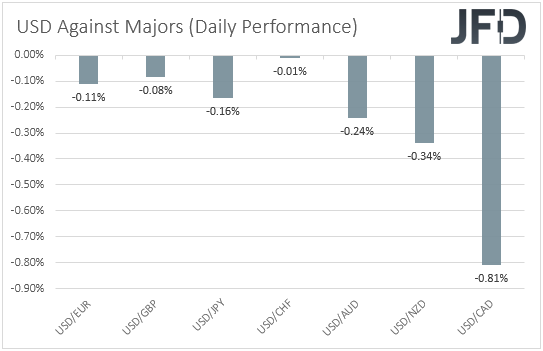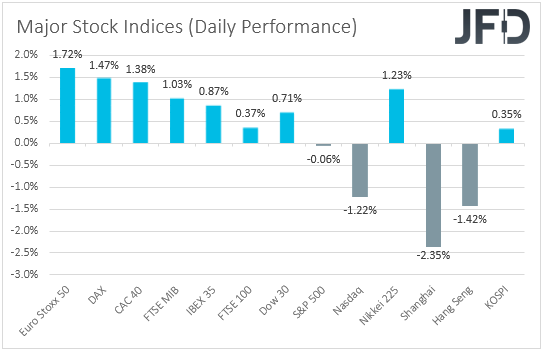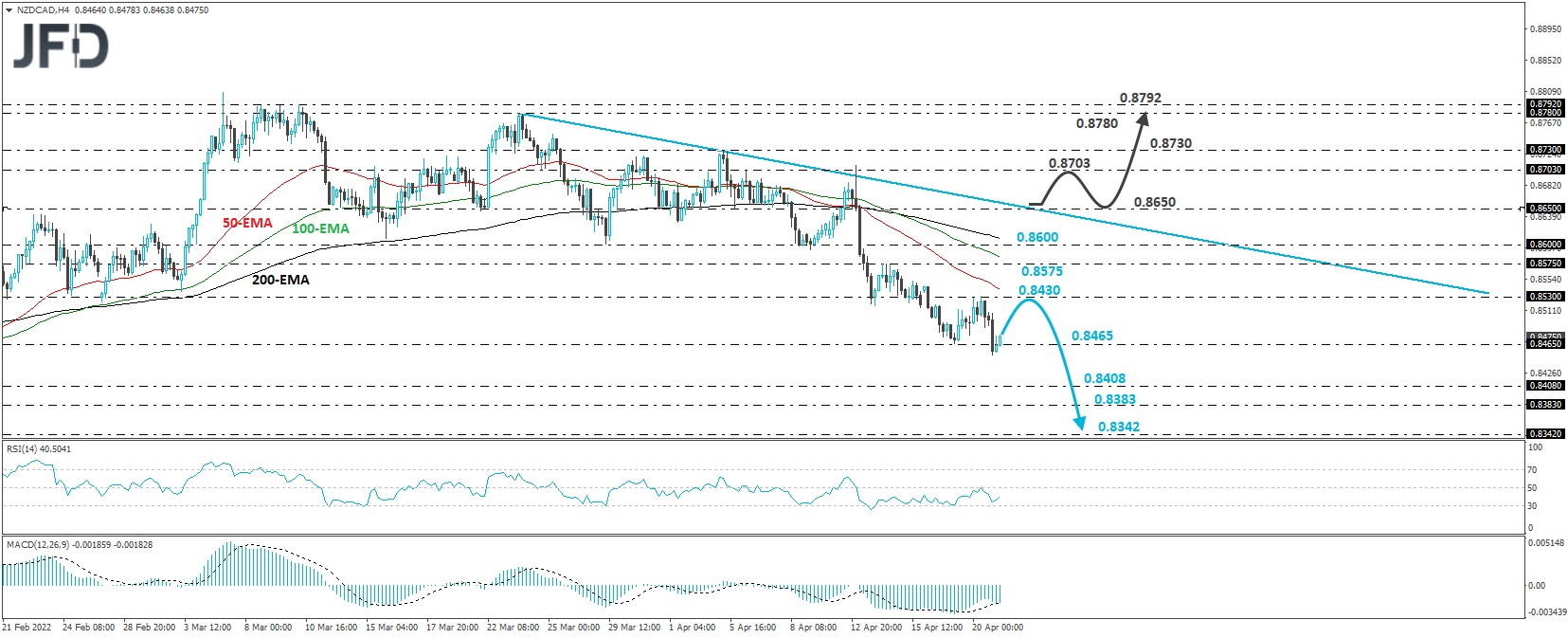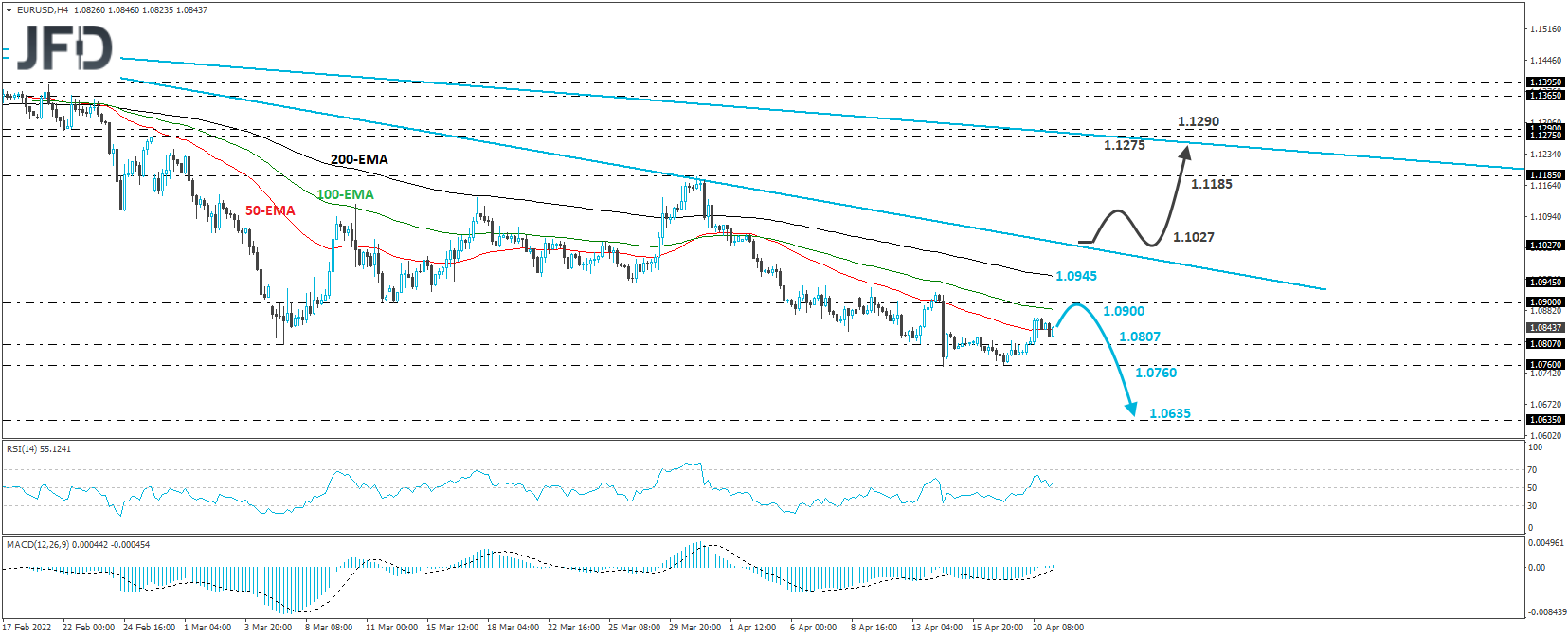European equities traded higher yesterday, but Wall Street saw NASDAQ falling more than 1%, perhaps due to a 35.1% plunge in Netflix (NASDAQ:NFLX). In the FX world, CAD was the main gainer among the majors, perhaps due to the higher-than-expected CPIs raising speculation for more aggressive tightening by the BoC. Today, the spotlight is likely to turn to Fed Chair Jerome Powell and ECB President Christine Lagarde, who could give more information with regards to the monetary policy plans of their respective Banks.
Canadian Dollar The Main Winner Among Majors, Fed's Powell And ECB's Largarde Speak
The US dollar traded lower against all but one of the other major currencies on Wednesday and during the Asian session Thursday. It lost the most ground against CAD, with NZD and AUD taking the second and third places respectively. The only currency against which the greenback did not underperform was CHF, with USD/CHF found virtually unchanged today.
The weakening of the US dollar and the safe-haven franc, combined with the fact that the risk-linked currencies were the main beneficiaries, suggests that market participants traded in a risk-on fashion yesterday and today in Asia. Turning our gaze to the equity world, we see that, indeed, major EU indices traded in the green, helped by a clutch of positive earnings.
However, later in the day, in the US, although the Dow Jones managed to climb a bit higher, the S&P 500 finished unchanged, while NASDAQ fell 1.22%, dragged by a 35.1% tumble in Netflix. The streaming giant saw its largest one-day fall in over a decade, after it reported a subscriber loss for the first time in over a decade. In Asia, Japan’s Nikkei and South Korea’s KOSPI rose, but China’s Shanghai Composite and Hong Kong’s Hang Seng fell, perhaps due to concerns that the zero-tolerance COVID policy in the world’s second largest economy will result in severe economic wounds.
As for our view, we are still reluctant to call for a bullish outlook in stock indices. Even if upbeat earnings results continue to add support, and even if they help NASDAQ to rebound, we believe that the overly hawkish expectations over central bank tightening, the uncertainty surrounding the war in Ukraine, and concerns surrounding the Chinese economy could keep any additional gains limited, at least until we see signs that all these are fully priced in.
Now back to the FX market, the Canadian dollar was the main gainer, and the fuel may have been the higher-than-expected Canadian CPIs for March, released yesterday. Both the headline and core rates rose by much more than anticipated, with the headline rate hitting a 31-year high, perhaps intensifying speculation that the BoC may need to continue raising rates aggressively, and why not deliver another 50bps increase when it meets next.
We got CPIs today as well, during the early Asian session, from New Zealand for Q1. The yoy rate rose notably here as well, but the difference was that it came in below estimates. Market participants have been already anticipating a higher rate. That’s maybe why we didn’t see the Kiwi outperforming the Loonie. Yet, it was the second gainer in line among the majors, as the data suggests that the RBNZ is also likely to deliver more rate hikes in the months to come. However, with the RBNZ hinting that it hiked more now so it can slow down later, we believe that between those two commodity-linked currencies, the Loonie is likely to perform better. In other words, we see the case for NZD/CAD to continue drifting south for a while more.
As for today, the spotlight is likely to fall to Fed Chair Jerome Powell, who is scheduled to speak at the spring meeting of the International Monetary Fund, while later in the day, he is due to take part in a panel discussion along with ECB President Christine Lagarde.
After raising interest rates at its latest gathering, the FOMC is now expected to deliver a double hike when it meets next, while there is more than 50% chance for a triple hike in June. Thus, with that in mind, it will be interesting to see whether Powell will maintain an ultra-hawkish tone, something that could encourage some more dollar buying.
At the same time, following a cautious approach at last week’s ECB meeting, we don’t expect Lagarde to sound similarly aggressive. At the press conference following last week’s gathering, she said that they will only start raising rates “some time” after the end of the APP, which is expected in Q3. It could be weeks or even several months, she added. Therefore, we expect her to stick to her guns, something that could highlight again the divergence in monetary policy between the Fed and the ECB, and perhaps push the EUR/USD pair even lower.
NZD/CAD Technical Outlook
NZD/CAD traded lower yesterday, after it hit resistance at 0.8530. However, the slide was stopped slightly below Tuesday’s low of 0.8465, and the, the rate rebounded somewhat. Overall, the rate continues to trade below the downside resistance line drawn from the high of Mar. 23, distancing itself from that line lately. Therefore, we will maintain a bearish stance for now.
The current bounce may continue for a while more, but the bears could recharge from near the 0.8530 territory and push for another test near 0.8465. A break lower could confirm a forthcoming lower low and may see scope for declines towards the 0.8408 or 0.8383 zones, marked by the lows of Feb. 16 and 7 respectively. If neither zone is able to halt the slide, then we may experience extensions towards the low of Jan. 28.
On the upside, we will consider the outlook to have turned bullish upon a break above 0.8650. Such a move may confirm the break above the aforementioned downside line and may see scope for advances towards the 0.8703 level, or the 0.8730 barrier, marked by the high of Apr. 5. Another break, above 0.8730 could allow the buyers to climb towards the 0.8780 barrier, which is marked by the high of Mar. 23.
EUR/USD Technical Outlook
EUR/USD traded slightly higher recently, after it hit support at 1.0760 twice. However, the pair remains below the downside line taken from the high of Feb. 10, as well as below a longer-term line, drawn from the high of June 1, 2021. In our view, this keeps the near-term picture negative.
We do see the case for the latest rebound to continue for a while more, but the bears may recharge from below the short-term downside line and push for another test near the 1.0760 territory. A break lower would confirm a forthcoming lower low and could set the stage for declines towards the 1.0635 area, defined as a support by the low of Mar. 22.
On the upside, a break above 1.1027 could signal a larger positive correction, but not a bullish reversal, as the pair will still be trading below the downside line taken from the high of June 1, 2021. We may see the bulls driving the battle towards the high of Mar. 31, at 1.1185, the break of which could aim for that longer-term downside lien, or the 1.1275 barrier, marked by the high of Feb. 25.
As For The Rest Of Today's Events
We get inflation data from the Eurozone for March. However, this will be the final data for the month, and as it is always the case, both the headline and core rates are forecast to confirm their preliminary estimates. The euro is unlikely to respond to this set.
